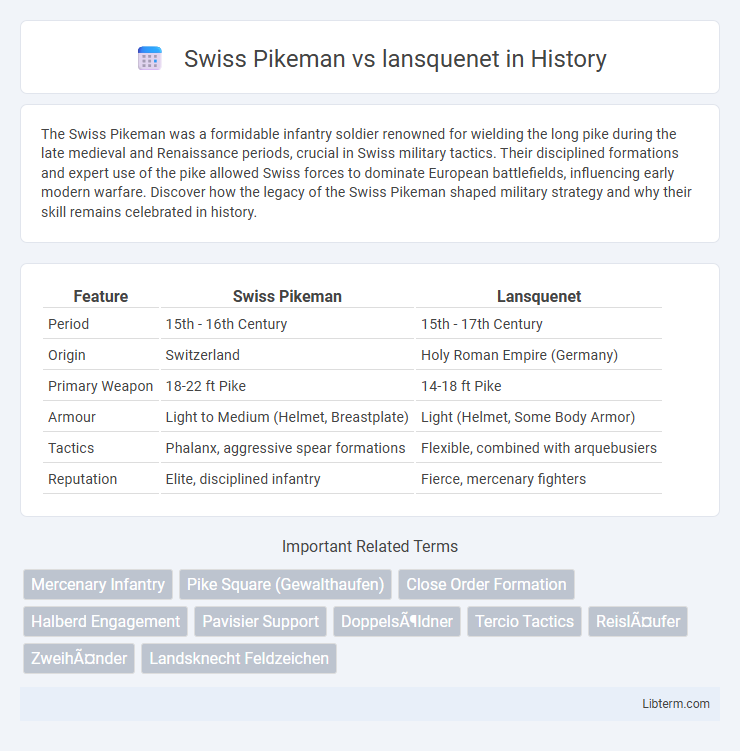The Swiss Pikeman was a formidable infantry soldier renowned for wielding the long pike during the late medieval and Renaissance periods, crucial in Swiss military tactics. Their disciplined formations and expert use of the pike allowed Swiss forces to dominate European battlefields, influencing early modern warfare. Discover how the legacy of the Swiss Pikeman shaped military strategy and why their skill remains celebrated in history.
Table of Comparison
| Feature | Swiss Pikeman | Lansquenet |
|---|---|---|
| Period | 15th - 16th Century | 15th - 17th Century |
| Origin | Switzerland | Holy Roman Empire (Germany) |
| Primary Weapon | 18-22 ft Pike | 14-18 ft Pike |
| Armour | Light to Medium (Helmet, Breastplate) | Light (Helmet, Some Body Armor) |
| Tactics | Phalanx, aggressive spear formations | Flexible, combined with arquebusiers |
| Reputation | Elite, disciplined infantry | Fierce, mercenary fighters |
Origins of Swiss Pikemen and Landsknechts
Swiss Pikemen originated in the 14th century as elite infantry units in Swiss cantons, renowned for their disciplined phalanx formations and mastery of the pike weapon. Landsknechts emerged in the late 15th century within the Holy Roman Empire, founded by Maximilian I to imitate and counter Swiss military tactics using similar pikemen tactics but with greater mercenary organization. Both forces revolutionized European warfare by emphasizing pike squares, yet Swiss Pikemen maintained a communal militia tradition, whereas Landsknechts operated as professional mercenaries.
Evolution of Pike Warfare in Europe
Swiss Pikemen revolutionized pike warfare in Europe during the late 15th and early 16th centuries, employing dense, disciplined formations known as pike squares (Gewalthaufen) that maximized offensive and defensive capabilities. Lansquenets, German mercenary pikemen adopting Swiss tactics, evolved by integrating heavier armor and incorporating combined arms strategies, including arquebusiers for flexible battlefield roles. This evolution marked the transition from medieval knight-centric warfare to early modern infantry dominance, influencing military tactics across European powers.
Recruitment and Training Methods
Swiss Pikemen underwent rigorous recruitment primarily through local cantons, emphasizing physical fitness, discipline, and communal responsibility, ensuring soldiers were highly motivated and cohesive. Their training involved intensive drills in pike formations, fostering unit precision and defensive tactics crucial for battlefield stability. Lansquenets recruited mercenaries across the Holy Roman Empire, valuing individual experience and battlefield adaptability, with training focusing on versatile combat skills and flexible formation tactics suitable for varied engagements.
Tactics and Battlefield Formations
Swiss Pikemen employed dense, wedge-shaped formations known as pike squares, maximizing offensive thrust and defensive integrity against cavalry and infantry alike. Lansquenets favored more flexible battlefield tactics, combining mixed formations of pikemen and arquebusiers to adapt quickly, using ranged firepower to disrupt enemy lines before engaging in close combat. The Swiss approach emphasized disciplined, heavy pike assaults with tight cohesion, whereas Lansquenets relied on tactical versatility and integrated arms to exploit battlefield dynamics.
Weapons and Armor Comparison
Swiss Pikemen primarily wielded long pikes measuring up to 18 feet, designed for tight infantry formations to counter cavalry charges, while Landsknechts used shorter pikes around 14 to 16 feet but paired them with arquebuses and two-handed swords for versatile combat. Swiss armor was typically lighter, favoring mobility with brigandines and partial plate, whereas Landsknechts often sported heavier and more flamboyant steel armor, including full helmets and breastplates for increased protection. The Swiss emphasis on disciplined pike formations contrasted with the Landsknechts' combined arms approach, blending pistol, sword, and pike to adapt to varied battlefield roles.
Iconic Battles and Key Engagements
Swiss Pikemen and Landsknechts clashed in iconic battles such as the Battle of Nancy (1477) and the Battle of Bicocca (1522), where the disciplined pike formations of the Swiss demonstrated superior cohesion against the Landsknechts' mixed pike and arquebus tactics. At the Battle of Morat (1476), Swiss infantry effectively used dense pike squares to break Landsknecht advances, showcasing the tactical importance of unit formation and morale. These engagements highlight the evolution of Renaissance warfare, with Swiss Pikemen pioneering pike tactics that influenced Landsknecht battlefield strategies.
Mercenary Culture and Military Reputation
Swiss Pikemen were renowned for their disciplined phalanx formations and expert use of long pikes, establishing a formidable reputation as elite mercenaries throughout 15th and 16th century Europe. Lansquenets, German mercenaries famous for their aggressive tactics and distinctive flamboyant dress, complemented the Swiss focus on pike warfare with more versatile combat roles including versatile infantry and handgunners. Both mercenary groups significantly influenced Renaissance warfare by combining professional soldiering with fierce loyalty to pay, shaping military culture and reputation across European battlefields.
Strengths and Weaknesses in Combat
Swiss pikemen excel in disciplined formation tactics and formidable defensive capabilities, using long pikes to maintain distance and disrupt enemy charges effectively. Lansquenets boast greater individual combat versatility and adaptability due to lighter armor and diverse weaponry, allowing swift offensive maneuvers and flexible battlefield roles. Swiss formations lose mobility and suffer vulnerability to ranged attacks, while lansquenets are less effective in sustained, tightly coordinated pike phalanxes.
Influence on European Military Doctrine
The Swiss Pikeman revolutionized European military doctrine with their disciplined phalanx formations, emphasizing tight cohesion and long pike use to counter cavalry charges effectively. Their tactics inspired the development of infantry-centric armies, shifting the balance from heavy cavalry dominance to combined arms strategies. The Landsknechts adopted and adapted Swiss pike tactics, integrating firearms like the arquebus, which further evolved European warfare by blending pike and shot formations for enhanced battlefield versatility.
Legacy in History and Modern Perception
The Swiss Pikeman and the Lansquenet represent two legendary infantry traditions whose tactical innovations influenced Renaissance warfare and shaped early modern military formations. The Swiss Pikeman's disciplined phalanx formations revolutionized close-combat tactics, while the Lansquenet's adaptability and mercenary ethos left a mark on European armies' evolution. Modern perception honors the Swiss Pikeman as a symbol of precision and unity, contrasting with the Lansquenet's rugged individualism, both embodying enduring legacies in martial heritage and historical military studies.
Swiss Pikeman Infographic

 libterm.com
libterm.com